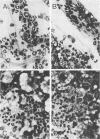Abstract
Visceral infection and metastatic lesion development following intravenous or subcutaneous inoculation of Leishmania mexicana amastigotes were examined in different B10 congenic mouse strains carrying alternative alleles at Lsh, H-2, or H-11. The results show that, despite a failure to observe any differences in rates of expansion of primary lesions in mice inoculated subcutaneously, each of these genes could be shown to exert some influence during visceralization and metastatic spread of L. mexicana infection. Of particular interest were (i) the continuous advantage observed throughout 160 to 200 days of infection in Lshr versus Lshs mice, (ii) the association between structural gene polymorphism at H-2 and profound visceral and metastatic spread of the parasite producing disease phenotypes akin to diffuse cutaneous leishmaniasis and post-kala-azar dermal leishmaniasis in humans, and (iii) similar effects observed in mice differing at H-11, the functional basis for which involves modified expression of major histocompatibility complex class II molecules. The results are discussed in relation to the human disease and the possibility that homologs for each of these genes regulate leishmanial infections in humans.
Full text
PDF






Images in this article
Selected References
These references are in PubMed. This may not be the complete list of references from this article.
- Blackwell J. M. Genetic control of recovery from visceral leishmaniasis. Trans R Soc Trop Med Hyg. 1982;76(2):147–151. doi: 10.1016/0035-9203(82)90262-0. [DOI] [PubMed] [Google Scholar]
- Blackwell J. M., Hale C., Roberts M. B., Ulczak O. M., Liew F. Y., Howard J. G. An H-11-linked gene has a parallel effect on Leishmania major and L. donovani infections in mice. Immunogenetics. 1985;21(4):385–395. doi: 10.1007/BF00430803. [DOI] [PubMed] [Google Scholar]
- Blackwell J. M. Leishmania donovani infection in heterozygous and recombinant H-2 haplotype mice. Immunogenetics. 1983;18(2):101–109. doi: 10.1007/BF00368537. [DOI] [PubMed] [Google Scholar]
- Blackwell J. M., Roberts M. B. Immunomodulation of murine visceral leishmaniasis by administration of monoclonal anti-Ia antibodies: differential effects of anti-I-A vs. anti-I-E antibodies. Eur J Immunol. 1987 Nov;17(11):1669–1672. doi: 10.1002/eji.1830171125. [DOI] [PubMed] [Google Scholar]
- Blackwell J., Freeman J., Bradley D. Influence of H-2 complex on acquired resistance to Leishmania donovani infection in mice. Nature. 1980 Jan 3;283(5742):72–74. doi: 10.1038/283072a0. [DOI] [PubMed] [Google Scholar]
- Bradley D. J. Regulation of Leishmania populations within the host. II. genetic control of acute susceptibility of mice to Leishmania donovani infection. Clin Exp Immunol. 1977 Oct;30(1):130–140. [PMC free article] [PubMed] [Google Scholar]
- Brown I. N., Glynn A. A., Plant J. Inbred mouse strain resistance to Mycobacterium lepraemurium follows the Ity/Lsh pattern. Immunology. 1982 Sep;47(1):149–156. [PMC free article] [PubMed] [Google Scholar]
- Crocker P. R., Blackwell J. M., Bradley D. J. Expression of the natural resistance gene Lsh in resident liver macrophages. Infect Immun. 1984 Mar;43(3):1033–1040. doi: 10.1128/iai.43.3.1033-1040.1984. [DOI] [PMC free article] [PubMed] [Google Scholar]
- Crocker P. R., Davies E. V., Blackwell J. M. Variable expression of the murine natural resistance gene Lsh in different macrophage populations infected in vitro with Leishmania donovani. Parasite Immunol. 1987 Nov;9(6):705–719. doi: 10.1111/j.1365-3024.1987.tb00540.x. [DOI] [PubMed] [Google Scholar]
- Davies E. V., Singleton A. M., Blackwell J. M. Differences in Lsh gene control over systemic Leishmania major and Leishmania donovani or Leishmania mexicana mexicana infections are caused by differential targeting to infiltrating and resident liver macrophage populations. Infect Immun. 1988 May;56(5):1128–1134. doi: 10.1128/iai.56.5.1128-1134.1988. [DOI] [PMC free article] [PubMed] [Google Scholar]
- Howard J. G., Hale C., Chan-Liew W. L. Immunological regulation of experimental cutaneous leishmaniasis. 1. Immunogenetic aspects of susceptibility to Leishmania tropica in mice. Parasite Immunol. 1980 Winter;2(4):303–314. doi: 10.1111/j.1365-3024.1980.tb00061.x. [DOI] [PubMed] [Google Scholar]
- Kaye P. M., Patel N. K., Blackwell J. M. Acquisition of cell-mediated immunity to Leishmania. II. LSH gene regulation of accessory cell function. Immunology. 1988 Sep;65(1):17–22. [PMC free article] [PubMed] [Google Scholar]
- Mock B. A., Fortier A. H., Potter M., Blackwell J., Nacy C. A. Genetic control of systemic Leishmania major infection: identification of subline differences for susceptibility to disease. Curr Top Microbiol Immunol. 1985;122:115–121. doi: 10.1007/978-3-642-70740-7_17. [DOI] [PubMed] [Google Scholar]
- Plant J. E., Blackwell J. M., O'Brien A. D., Bradley D. J., Glynn A. A. Are the Lsh and Ity disease resistance genes at one locus on mouse chromosome 1? Nature. 1982 Jun 10;297(5866):510–511. doi: 10.1038/297510a0. [DOI] [PubMed] [Google Scholar]
- Sacks D. L., Barral A., Neva F. A. Thermosensitivity patterns of Old vs. New World cutaneous strains of Leishmania growing within mouse peritoneal macrophages in vitro. Am J Trop Med Hyg. 1983 Mar;32(2):300–304. doi: 10.4269/ajtmh.1983.32.300. [DOI] [PubMed] [Google Scholar]
- Skamene E., Gros P., Forget A., Kongshavn P. A., St Charles C., Taylor B. A. Genetic regulation of resistance to intracellular pathogens. Nature. 1982 Jun 10;297(5866):506–509. doi: 10.1038/297506a0. [DOI] [PubMed] [Google Scholar]
- Skamene E., Gros P., Forget A., Patel P. J., Nesbitt M. N. Regulation of resistance to leprosy by chromosome 1 locus in the mouse. Immunogenetics. 1984;19(2):117–124. doi: 10.1007/BF00387854. [DOI] [PubMed] [Google Scholar]
- Ulczak O. M., Blackwell J. M. Immunoregulation of genetically controlled acquired responses to Leishmania donovani infection in mice: the effects of parasite dose, cyclophosphamide and sublethal irradiation. Parasite Immunol. 1983 Sep;5(5):449–463. doi: 10.1111/j.1365-3024.1983.tb00760.x. [DOI] [PubMed] [Google Scholar]



